Have you ever gazed up at the night sky and wondered about the celestial wonders above? One breathtaking constellation that has fascinated astronomers and stargazers alike is the Ursa Minor. Commonly known as the Little Bear or the Little Dipper, Ursa Minor is a constellation that holds great significance in both ancient mythology and modern astronomy. In this article, we will take a closer look at the origins, stars, constellation pattern, deep sky objects, historical significance, and modern understanding of the Ursa Minor constellation. Get ready to embark on a journey through the cosmos as we explore the wonders of the Great Bear, Ursa Minor.
Contents
- Ancient Origins
- The Stars of Ursa Minor
- Exploring Ursa Minor’s Constellation Pattern
- Deep Sky Objects in Ursa Minor
- Historical Significance
- Modern Understanding and Observation
- Conclusion
-
Frequently Asked Questions
- 1. What is the meaning of Ursa Minor?
- 2. How can I locate Ursa Minor in the night sky?
- 3. Is Ursa Minor visible from both hemispheres?
- 4. What is the significance of Polaris as the North Star?
- 5. Are there any notable stars in Ursa Minor other than Polaris?
- 6. Are there any deep sky objects in Ursa Minor?
- 7. Why was Ursa Minor important in early navigation?
- 8. How did ancient cultures interpret Ursa Minor?
- 9. Have there been any scientific discoveries related to Ursa Minor?
- 10. Are there any tips for stargazing Ursa Minor?
- References
-
Frequently Asked Questions
- 1. How can I find Ursa Minor in the night sky?
- 2. What is the significance of the North Star, Polaris?
- 3. Are there any other notable stars in the Ursa Minor constellation?
- 4. What is the story behind the Ursa Minor constellation?
- 5. What deep sky objects can be observed within Ursa Minor?
- 6. What was the role of Ursa Minor in ancient navigation?
- 7. How did ancient cultures interpret the Ursa Minor constellation?
- 8. What are some notable scientific studies and discoveries related to Ursa Minor?
- 9. Any tips for stargazing in the Ursa Minor constellation?
- 10. What is the historical significance of Ursa Minor?
- References
- Read More
Ancient Origins
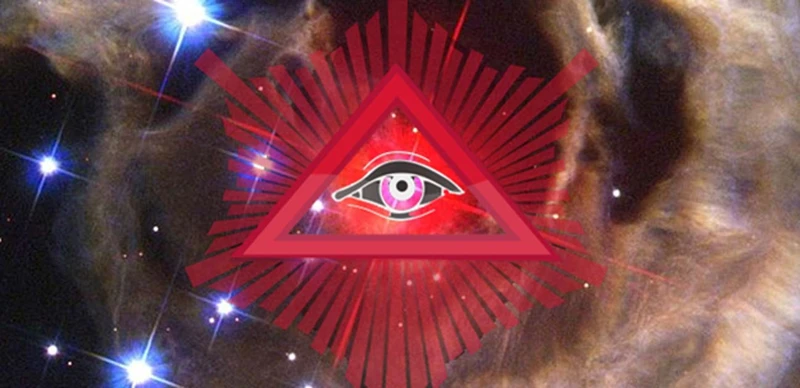
The ancient origins of the Ursa Minor constellation can be traced back to various mythologies and cultures. In Roman mythology, the story of Ursa Minor revolves around a nymph named Callisto. According to the myth, Callisto caught the eye of the mighty Zeus, who disguised himself as the goddess Artemis to approach her. When Artemis discovered Callisto’s pregnancy, she banished her from her sight. After giving birth to a son, Callisto and her child were transformed into bears by a jealous Hera. Zeus, in an act of mercy, placed them both in the sky as Ursa Major and Ursa Minor.
This mythological significance is not limited to just the Romans. In Greek mythology, Ursa Minor is associated with Arcas, the son of Zeus and Callisto. Arcas was later placed in the sky as the constellation Boötes, the Bear Watcher, to watch over his mother and prevent her from wandering too far from her place.
The ancient Chinese astronomers also identified Ursa Minor as part of the Azure Dragon constellation, one of the four symbols of the Chinese constellations. The Azure Dragon symbolized power and protection and was often associated with the emperor and celestial harmony.
The rich history of mythology and cultural significance surrounding Ursa Minor highlights the enduring fascination and reverence humans have had for the night sky throughout the ages. Whether it be through stories of gods and nymphs or as a symbol of power, Ursa Minor has captivated our collective imagination for centuries.
For more interesting information on Roman mythology, you can check out our article on the origin and history of Roman mythology. It provides an in-depth exploration of the stories and beliefs that shaped ancient Roman culture.
The Story of Ursa Minor
The story of Ursa Minor revolves around the nymph Callisto and her son Arcas in Greek mythology. Callisto was a beautiful huntress who caught the eye of Zeus, king of the gods. Zeus, in an attempt to hide his affair from his wife Hera, transformed himself into the goddess Artemis and approached Callisto. The ruse eventually unraveled when Artemis discovered Callisto’s pregnancy. Enraged, Artemis banished Callisto from her sight. After giving birth to her son Arcas, Callisto and Arcas were turned into bears by a jealous Hera.
In an act of mercy, Zeus immortalized Callisto and Arcas by placing them in the night sky. Callisto became Ursa Major, the Great Bear, and Arcas became Ursa Minor, the Little Bear. Ursa Minor is often portrayed as a cub following its mother, Ursa Major, in the night sky.
The story of Ursa Minor serves as a cautionary tale about the consequences of Zeus’s infidelity and Hera’s jealousy. It also explains the eternal bond between Ursa Major and Ursa Minor, as they are forever connected in the celestial realm.
To learn more about fascinating scientific discoveries in the field of astronomy, you can explore our article on the scientific discoveries of Ophiuchus and observations. It delves into the latest breakthroughs in our understanding of the cosmos and the tools employed by astronomers to unravel its mysteries.
Mythological Significance
The mythological significance of the Ursa Minor constellation extends beyond its association with Callisto and Arcas. In Greek mythology, Ursa Minor is also linked to the story of the nymph Calypso, who was known for her beauty and enchanting singing voice. The great hero Odysseus encountered Calypso during his arduous journey back to his homeland. Calypso, captivated by Odysseus, offered him eternal life and immortality if he stayed with her on her island. However, Odysseus longed for his wife, Penelope, and declined Calypso’s offer.
The Ursa Minor constellation plays a role in this myth as it represents Calypso’s grief and longing for Odysseus. In some versions of the story, it is believed that Calypso’s tears transformed into the stars of Ursa Minor. This tale showcases the emotional depth and complexity attributed to the stars and constellations in ancient mythology.
Beyond Greek mythology, Ursa Minor holds significance in other cultures as well. In Norse mythology, Ursa Minor is associated with the wagon of Thor, the god of thunder. It was believed that Thor would ride his wagon across the night sky, with Ursa Minor serving as a symbol of his strength and power.
The mythological significance of Ursa Minor is a testament to the human fascination with the stars and the desire to create stories and meaning around them. These stories allowed ancient civilizations to make sense of the celestial wonders and pass down their cultural beliefs and values.
For more information on astronomical events and celestial phenomena, you can explore our article on planetary alignment and other astronomical events. It provides insights into the alignment of planets, meteor showers, and other captivating occurrences in the night sky.
The Stars of Ursa Minor
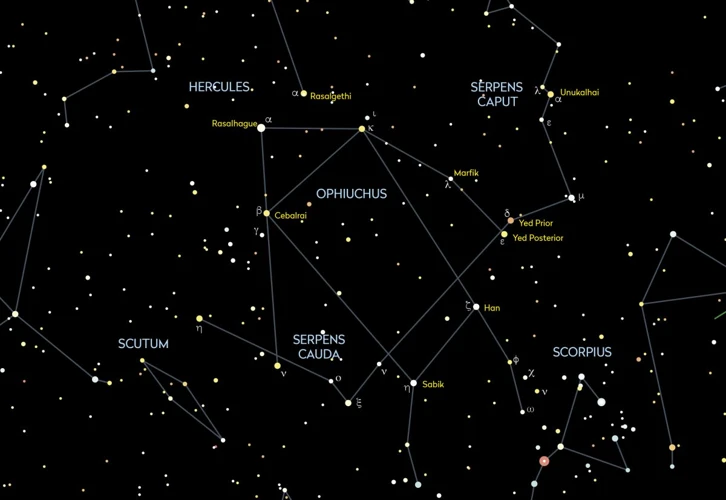
The Ursa Minor constellation is home to several notable stars, with Polaris, also known as the North Star, being the most famous. Polaris holds immense significance for navigators and stargazers alike, as it remains almost stationary in the night sky, aligning closely with the Earth’s North Pole. This consistent position makes Polaris a reliable compass for determining direction, particularly for those in the Northern Hemisphere. Its brightness and prominent location within the Ursa Minor constellation make it relatively easy to spot.
Aside from Polaris, Ursa Minor features other noteworthy stars. Kochab, a bright orange giant, is the second brightest star in the constellation. It sits at the base of the “bowl” of the Little Dipper, adjacent to Polaris. Kochab’s name is derived from an Arabic term meaning “the star of the North,” emphasizing its proximity to Polaris.
Another notable star is Pherkad, located near Kochab and forming a line with Polaris. Pherkad is a binary star system, consisting of two stars orbiting around a common center of mass. These stars both emit a blue-white light and are estimated to be much larger and more massive than our Sun.
Alrai, also known as Gamma Ursae Minoris, is an interesting star located in the Ursa Minor constellation. It is a multiple star system composed of three stars, with the primary star being a yellow-hued giant. The other two stars in the system are smaller and orbit the primary star.
These remarkable stars contribute to the allure of the Ursa Minor constellation, drawing both amateur astronomers and enthusiasts of celestial navigation into its captivating celestial embrace. Whether used as a guide for navigation or simply admired as celestial gems, the stars of Ursa Minor continue to inspire wonder and curiosity in those who explore the night sky.
Polaris: The North Star
At the heart of the Ursa Minor constellation lies its most famous star, Polaris, also known as the North Star or Pole Star. Polaris holds a special place in astronomy and navigation due to its unique characteristics. Here are some key facts about this remarkable celestial body:
1. Location: Polaris is located at the end of the handle of the Little Dipper, which is part of Ursa Minor. It serves as the closest easily identifiable star to the celestial north pole. This positioning makes it an invaluable reference point for navigators and astronomers.
2. Fixed Position: Unlike other stars in the sky that appear to move as the Earth rotates on its axis, Polaris remains almost stationary. It appears to be fixed in the northern sky, making it an excellent navigational tool. Sailors and travelers have long relied on Polaris to determine their north-south position.
3. Importance in Navigation: Polaris has been crucial for navigation throughout history. Using Polaris and its celestial alignment, sailors in the Northern Hemisphere can easily identify the direction of true north. From there, they can navigate their way by accurately determining their latitude.
4. Stellar Classification: Polaris is a yellow supergiant star, with a luminosity nearly 2,000 times that of our Sun. In terms of temperature, it is relatively cooler than other stars but still shines brightly in our night sky.
5. Distance from Earth: Polaris is located approximately 323 light-years away from Earth, making it relatively close in astronomical terms. Despite the distance, it appears to be one of the most prominent stars due to its brightness and fixed position.
6. Circumpolar Star: Due to its proximity to the celestial north pole, Polaris is visible all year round in the Northern Hemisphere. It remains above the horizon, making it a circumpolar star. Its position near the north celestial pole gives it a significant advantage in stargazing and navigation.
The significance of Polaris as the North Star cannot be overstated. Its stability, brightness, and consistent position have made it an essential guide for sailors, astronomers, and explorers throughout history. Having a reliable fixed point in the night sky has greatly assisted in the mapping of the Earth and our understanding of the wider universe.
Other Notable Stars
Apart from the prominent Polaris, the North Star, the Ursa Minor constellation also features several other notable stars that add to its celestial beauty. One of these stars is Kochab, a bright giant star located about 126 light-years away from Earth. With an apparent magnitude of 2.08, Kochab is visible to the naked eye and serves as a useful marker for locating the North Star. Another noteworthy star is Pherkad, which is slightly fainter than Kochab with an apparent magnitude of 3.05. Pherkad is a binary star system consisting of two stars orbiting around a common center of mass. These two stars, separated by approximately 19 astronomical units, create a mesmerizing visual spectacle for stargazers. Additionally, Alifa al Farkadain, also known as Epsilon Ursae Minoris, is a binary star system located about 333 light-years away. The primary star in this system belongs to the spectral class K4III and has an apparent magnitude of 4.2. These other notable stars in the Ursa Minor constellation contribute to its stellar allure and offer astronomers and stargazers a multitude of celestial wonders to explore.
Exploring Ursa Minor’s Constellation Pattern
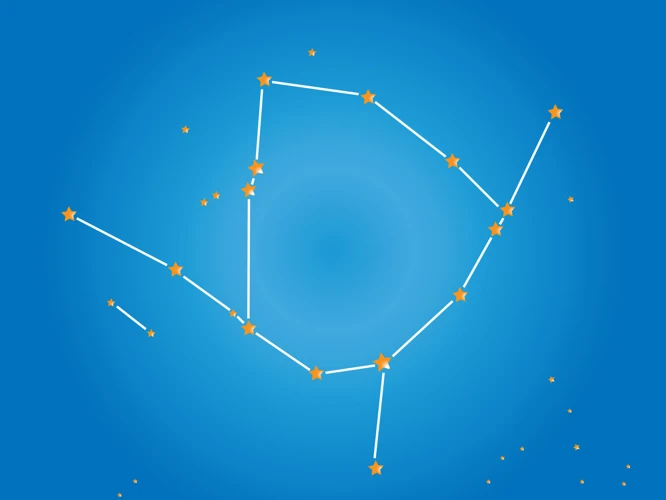
Exploring the constellation pattern of Ursa Minor is an exciting adventure for stargazers and astronomers. The most recognizable feature of Ursa Minor is the Little Dipper, a group of stars that form a distinct shape resembling a ladle or dipper. The two stars at the end of the dipper’s bowl are known as the “Guardians of the Pole,” referring to their role in guiding navigators and aiding in celestial navigation.
Here is a list of the stars that form the Little Dipper in Ursa Minor:
1. Polaris (Alpha Ursae Minoris): The most famous star in Ursa Minor is Polaris, also known as the North Star. It occupies a special place as the closest visible star to the celestial north pole, making it a crucial navigational marker for centuries. Polaris appears bright and steady, serving as a reliable reference point for finding one’s bearings in the night sky.
2. Kochab (Beta Ursae Minoris): Kochab is the second-brightest star in Ursa Minor and an essential component of the Little Dipper. Although not as well-known as Polaris, Kochab is notable for its prominence in the northern sky and its position relative to the North Star.
3. Pherkad (Gamma Ursae Minoris): Pherkad, also known as Pherkad Major, is a double star system composed of two almost equally bright stars. Together with Kochab, Pherkad forms the outer edge of the Little Dipper’s bowl.
4. Yildun (Delta Ursae Minoris): Yildun is a relatively dim star located within the Little Dipper. While not as visually striking as the other stars in Ursa Minor, it plays a vital role in completing the dipper shape.
These stars, along with several others, complete the beautiful constellation pattern of Ursa Minor. The Little Dipper’s shape may seem modest compared to other constellations, but its significance in navigation and its connection to stories and myths make it an enchanting part of the night sky.
For more information on celestial navigation and the importance of Ursa Minor in early exploration, check out our article on early navigation and Ursa Minor’s role. Discover how ancient mariners relied on the stars to navigate the vast oceans and unlock the secrets of the world.
Identifying the Little Dipper
Identifying the Little Dipper within the Ursa Minor constellation can be an exciting endeavor for stargazers. The Little Dipper is composed of seven main stars arranged in the shape of a ladle or dipper. The most prominent star in the Little Dipper is Polaris, also known as the North Star. Polaris holds great navigational significance as it appears almost directly above the North Pole and remains fixed while the other stars appear to rotate around it. This makes Polaris a reliable reference point for navigation, especially for those in the Northern Hemisphere.
To locate the Little Dipper, it is helpful to first find the constellation Ursa Major, which is more commonly known as the Big Dipper. The two constellations are located close to each other in the night sky, with the handle of the Big Dipper serving as a pointer to the handle of the Little Dipper.
Once you have located the Big Dipper, follow the curve of the handle towards the Little Dipper. The two outermost stars of the Big Dipper’s bowl, Merak and Dubhe, are often referred to as the “Pointer Stars” as they guide your eyes towards Polaris, the North Star, which is the last star of the Little Dipper’s handle.
It’s important to note that the Little Dipper may not be as easily visible in areas with significant light pollution. Observing the night sky from a darker location can greatly enhance your chances of spotting the delicate constellation.
Identifying and tracing the shape of the Little Dipper can be a rewarding experience for both amateur astronomers and casual stargazers. Take the time to familiarize yourself with the positions of the stars, and you will gain a deeper appreciation for the beauty and wonder of the Ursa Minor constellation.
Connecting the Dots: Forming Ursa Minor
Connecting the dots and forming the Ursa Minor constellation requires a bit of imagination and careful observation. Ursa Minor, also known as the Little Dipper, is composed of seven main stars that form a distinctive shape resembling a ladle or a saucepan. These stars are often referred to as “the handle” and “the bowl” of the Little Dipper.
To identify Ursa Minor, first locate Polaris, also known as the North Star. Polaris is the brightest star in Ursa Minor and serves as a reliable guide for navigation, as it remains virtually stationary in the northern sky. Finding Polaris can be done by identifying the Big Dipper and imagining a line extending from the two outermost stars of its bowl towards the Little Dipper.
Once Polaris is identified, it becomes easier to connect the remaining stars of Ursa Minor. The handle of the Little Dipper bends from Polaris, forming an arc. From the end of the handle, two stars extend downwards to create the bottom part of the ladle shape. These stars are known as Kochab and Pherkad.
Polaris, Kochab, and Pherkad are the three most prominent stars in the Ursa Minor constellation. The remaining four stars complete the shape of the Little Dipper’s bowl. While not as bright as the others, these stars contribute to the overall formation of the constellation.
Observing and connecting the dots to form Ursa Minor can be a fascinating exercise, especially when considering the historical and cultural significance associated with this constellation. It serves as a celestial guidepost and a symbol of navigation, capturing the human spirit’s innate curiosity and desire to explore the mysteries of the night sky.
Deep Sky Objects in Ursa Minor
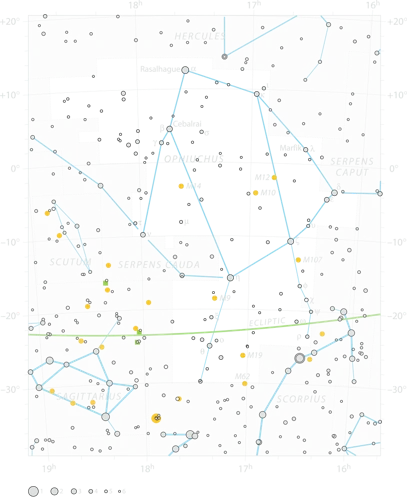
Deep sky objects in the Ursa Minor constellation provide a captivating glimpse into the vastness of the universe. One notable object is the spiral galaxy NGC 3928. Located approximately 60 million light-years away from Earth, NGC 3928 showcases beautiful spiral arms and a bright central bulge. Its intricate structure and celestial beauty make it a popular target for astronomers and astrophotographers.
Another intriguing deep sky object in Ursa Minor is the Ursa Minor Dwarf galaxy. This satellite galaxy of the Milky Way is relatively small, measuring only around 30,000 light-years in diameter. Due to its faint and elusive nature, early observations of this dwarf galaxy were challenging. However, modern technology and advancements in astronomical instruments have allowed for a closer study of the Ursa Minor Dwarf. Scientists have been able to gather valuable insights into the nature and composition of this intriguing celestial companion.
Exploring these deep sky objects within the Ursa Minor constellation not only broadens our understanding of the universe but also serves as a reminder of the sheer magnitude and complexity of celestial phenomena. The study of these objects provides valuable data for astronomers and contributes to our ever-growing knowledge of the cosmos.
The Spiral Galaxy: NGC 3928
Nestled within the Ursa Minor constellation, a remarkable deep sky object awaits discovery: the spiral galaxy known as NGC 3928. This stunning galaxy, located approximately 60 million light-years away from Earth, captivates astronomers and astrophotographers alike with its intricate structure and celestial beauty. NGC 3928 is classified as a barred spiral galaxy, characterized by its distinct central bar-shaped feature. This galaxy boasts striking spiral arms that gracefully sweep outward from the bar, showcasing intricate dust lanes, star-forming regions, and clusters of young, hot stars. With a visual magnitude of 11.8, NGC 3928 is within the reach of amateur telescopes, allowing even enthusiasts to catch a glimpse of its awe-inspiring beauty. This celestial gem serves as a reminder of the countless wonders that lie within the expanse of the Ursa Minor constellation, inviting us to delve further into the mysteries of the cosmos. The study and observation of NGC 3928 provide invaluable insights into the formation and evolution of galaxies, contributing to our overall understanding of the vast universe in which we reside.
Ursa Minor Dwarf: The Elusive Satellite Galaxy
The Ursa Minor constellation not only contains visible stars but also harbors a fascinating celestial object known as the Ursa Minor Dwarf, which is an elusive satellite galaxy. Discovered in the mid-20th century, the Ursa Minor Dwarf is an intriguing astronomical find due to its small size and proximity to our own galaxy, the Milky Way. This dwarf galaxy is located about 225,000 light-years away from Earth, making it one of the closest galaxies to us. Despite its proximity, it remained undiscovered until the 1950s when astronomers began to study it more closely.
The Ursa Minor Dwarf has a unique appearance and composition. It is classified as a dwarf spheroidal galaxy, which means it is roughly spherical in shape and lacks the prominent spiral arms observed in larger galaxies. Its size, estimated to be around 5,000 light-years in diameter, makes it significantly smaller than the Milky Way and many other galaxies in the universe.
One of the most intriguing aspects of the Ursa Minor Dwarf is its low amount of visible matter. Astronomers have determined that it contains relatively few stars compared to galaxies of similar size. Additionally, it is dominated by dark matter, a mysterious substance that cannot be directly observed but exerts a gravitational pull on visible matter. The Ursa Minor Dwarf’s high ratio of dark matter to visible matter has puzzled scientists and has prompted further research into the nature of galaxies and dark matter.
Studying the Ursa Minor Dwarf provides valuable insights into the formation and evolution of galaxies and helps astronomers refine their understanding of dark matter and its role in the universe. Its proximity and unique characteristics make it an excellent target for ongoing scientific investigations. As technology and research methods continue to advance, we can expect to uncover more fascinating details about this elusive satellite galaxy and its place within the cosmos.
Historical Significance

The historical significance of the Ursa Minor constellation stretches beyond its mythological associations. It played a crucial role in early navigation and had great practical importance for ancient sailors and travelers. Due to the proximity of Ursa Minor to the North Pole, it provided a reliable reference point for determining direction, particularly the cardinal direction of North. The stars of Ursa Minor, most notably Polaris, also known as the North Star, served as a guiding beacon for sailors in the northern hemisphere.
During ancient times, when sophisticated navigational tools were nonexistent, mariners relied on the position of the North Star to navigate vast oceans. By aligning their position with Polaris, sailors could determine their latitude and maintain a steady course. The constancy of Polaris being almost directly above the North Pole, regardless of the Earth’s rotation, allowed for a reliable navigation point even when other stars moved across the night sky.
Ursa Minor’s historical significance can be seen in the works of ancient astronomers and explorers. Ptolemy, the renowned Greek astronomer, included Ursa Minor and the position of the North Star in his influential work, Almagest, which served as a comprehensive guide to the stars. In the 15th century, the Arab navigator Ahmad ibn Majid documented the importance of the North Star in his navigation manual, emphasizing its crucial role in guiding ships across vast distances.
Ursa Minor had symbolic and cultural significance in ancient civilizations. In Norse mythology, Ursa Minor was believed to be the wagon of the god Thor, emphasizing its connection to strength and protection. Native American tribes, such as the Navajo, associated the constellation with the celestial guardian of the north.
The historical significance of Ursa Minor highlights its vital role in exploration, travel, and cultural beliefs. It stands as a testament to humanity’s ingenuity and adaptability in navigating the world using the stars as our guideposts.
Early navigation relied heavily on the observation of celestial bodies, and Ursa Minor played a crucial role in guiding sailors and explorers across the seas. Due to its unique position, Ursa Minor contains the North Star, Polaris. As the name implies, Polaris is the star that aligns approximately with the Earth’s North Pole. This made it an invaluable navigational tool for sailors in the northern hemisphere.
By locating Polaris and determining its altitude above the horizon, sailors could establish their latitude and navigate accurately. The position of Polaris relative to the horizon remains nearly fixed, providing a dependable reference point for navigation, especially during night journeys when other landmarks may not be readily visible.
To locate Polaris within Ursa Minor, navigators would identify the easily recognizable pattern of the Little Dipper or the handle of the Big Dipper constellation. The two outermost stars of the Big Dipper’s bowl point directly to Polaris, guiding mariners on their course. This made Ursa Minor an essential constellation in nautical lore and early exploration.
Indeed, the reliable presence of Polaris and the Ursa Minor constellation played a profound role in shaping the course of human history. It enabled ancient sailors to venture into uncharted waters, discover new lands, and ultimately paved the way for further exploration and expansion across the globe.
The significance of Ursa Minor in early navigation highlights the practical applications of understanding and observing the night sky. By unlocking the secrets of the constellations, ancient civilizations were able to navigate the vast oceans with confidence, turning the night sky into a celestial compass guiding the way to new discoveries.
For more fascinating information on the celestial world, check out our article on scientific discoveries and Ophiuchus observations. It delves into the intriguing world of astronomical revelations and the advancements made in our understanding of the universe.
Ursa Minor in Ancient Cultures
Ursa Minor, the Little Bear constellation, holds great significance in ancient cultures around the world. Let’s take a closer look at how Ursa Minor was perceived and interpreted in different civilizations.
1. Greek and Roman Cultures:
– In Greek mythology, Ursa Minor was associated with the tragic story of Callisto and her son Arcas, who were transformed into bears and placed in the sky by Zeus.
– The Greeks also believed that Ursa Minor and Ursa Major, collectively known as the Bears, were the nursemaids of the infant Zeus.
– In Roman mythology, Ursa Minor was closely linked to the story of Callisto, just like in Greek mythology.
2. Native American Cultures:
– The Native American tribes of the Great Plains viewed Ursa Minor as a celestial buffalo, symbolizing abundance, fertility, and the season of harvest.
– Some tribes saw Ursa Minor as part of the “world tree,” connecting the heavenly realms with the earthly realms.
3. Chinese Culture:
– Ursa Minor was associated with the Azure Dragon constellation in Chinese astronomy known as Qing Long.
– Qing Long represented the east and the element of wood and symbolized power, the emperor, and the spring season.
4. Norse Culture:
– Norse mythology identified Ursa Minor as Hróðvitnir, the “Famous Wolf,” that followed the constellation of Ursa Major, the Great Bear.
– Ursa Minor was believed to be pursued by the mythical hunter, Odin.
5. Inuit Culture:
– Among the Inuit peoples of North America, Ursa Minor is known as “Qilak,” the Big Dipper.
– Qilak is the hunting bow of Ataaqqina, the Great Spirit, and its handle is said to point towards the north star – Polaris.
These various interpretations and cultural significances of Ursa Minor demonstrate the universal human fascination with the night sky. It speaks to our innate desire to understand and navigate the vast cosmos, as well as the unique ways in which different cultures have made sense of the celestial wonders above.
Modern Understanding and Observation
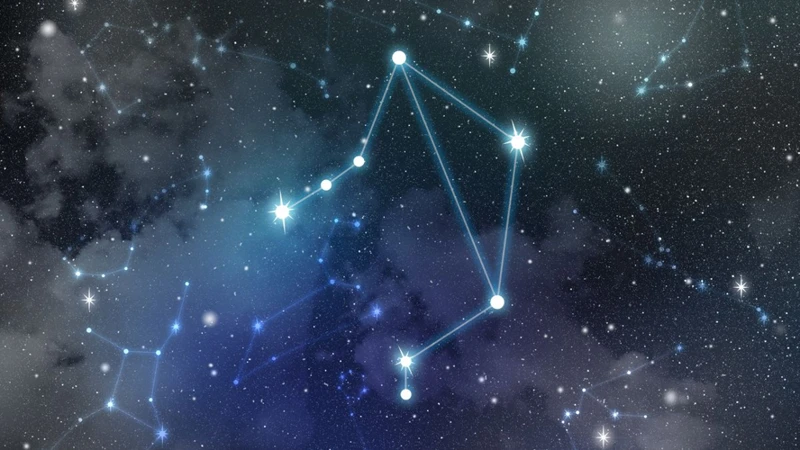
In modern times, our understanding and observation of the Ursa Minor constellation have been greatly enhanced through advancements in technology and scientific studies. Astronomers have discovered intriguing insights about the stars and phenomena within Ursa Minor, contributing to our knowledge of the universe.
Scientific studies have revealed that one of the most notable stars in Ursa Minor is Polaris, commonly known as the North Star. Polaris holds a special place in navigation as it has helped sailors, explorers, and travelers find their way for centuries. Its position almost exactly aligns with the axis of the Earth’s rotation, making it appear stationary in the night sky, serving as a reliable guide for determining north. This remarkable celestial feature has played a crucial role in early navigation and continues to be a valuable reference point for sailors and astronomers.
Another intriguing aspect of Ursa Minor is the presence of other notable stars apart from Polaris. These stars form the distinctive pattern of the Little Dipper, with Polaris serving as the tip of the handle. Kochab and Pherkad, two bright stars in Ursa Minor, are often referred to as the Guardians of the Pole. These stars, along with Polaris, create a unique celestial configuration that has fascinated stargazers throughout history.
With the advent of modern telescopes and technology, astronomers have been able to delve deeper into the mysteries of Ursa Minor. Through scientific observations, they have discovered various deep sky objects within the constellation. One such object is the spiral galaxy known as NGC 3928. Located in the constellation’s northeast region, NGC 3928 showcases the beauty of cosmic formations, providing insights into the evolution and structure of galaxies.
Additionally, Ursa Minor is home to the Ursa Minor Dwarf, an elusive satellite galaxy. This dwarf galaxy is orbiting around our Milky Way and is one of the least massive known galaxies in the Local Group. Its discovery has added to our understanding of galactic dynamics and the formation of galaxies in our cosmic neighborhood.
As technology continues to advance, astronomers can delve even further into the mysteries of Ursa Minor and unlock new discoveries. By studying the stars, deep sky objects, and the intricate patterns of this constellation, scientists can gain valuable insights into the origins and evolution of our universe.
For more fascinating scientific studies and observations, you can explore our article on scientific discoveries and Ophiuchus observations. It delves into the intriguing findings and breakthroughs in the field of astronomy, providing a glimpse into the wonders of the cosmos.
Scientific Studies and Discoveries
Scientific studies and discoveries have further enhanced our understanding of the Ursa Minor constellation. One significant scientific contribution is the discovery that Polaris, the North Star, is located within the Ursa Minor constellation. Polaris has played a crucial role in navigation since ancient times due to its proximity to the North Celestial Pole. Its fixed position in the sky allowed sailors and explorers to determine their latitude and navigate with greater accuracy.
In addition to Polaris, astronomers have made remarkable discoveries within the Ursa Minor constellation. For instance, a study conducted in recent years identified a supermassive black hole at the center of a dwarf galaxy within the Ursa Minor constellation. This finding has provided valuable insights into the formation and evolution of galaxies.
Another intriguing discovery is the presence of exoplanets within the Ursa Minor constellation. Exoplanets, or planets outside of our solar system, have been detected orbiting stars within this constellation. These discoveries not only expand our knowledge of planetary systems but also fuel the ongoing search for habitable worlds and potential extraterrestrial life.
Scientists have also used advanced observational techniques and technologies to study the properties and characteristics of individual stars within Ursa Minor. Through spectroscopic analysis, astronomers have been able to determine the age, composition, and evolutionary stage of these stars, unraveling the mysteries of stellar evolution.
Advancements in astrophotography have enabled researchers to capture stunning images of deep sky objects within the Ursa Minor constellation. This imagery allows for detailed study of galaxies, nebulae, and star clusters, providing insights into their formation and structure.
The constant pursuit of scientific knowledge and the use of innovative technologies have undoubtedly deepened our understanding of the Ursa Minor constellation. With each new discovery, we gain a greater appreciation for the beauty and complexity of the cosmos.
For more fascinating information on scientific discoveries and observations, you can explore our article on the scientific discoveries and observations of the Ophiuchus constellation. It uncovers the groundbreaking findings made by astronomers in relation to this enigmatic constellation.
Stargazing Tips for Ursa Minor
When it comes to stargazing, Ursa Minor offers a captivating experience for both beginners and seasoned astronomers. To make the most of your stargazing session with Ursa Minor, here are some helpful tips to keep in mind:
1. Find a Dark Sky Location: To observe Ursa Minor and its stars clearly, it’s best to head to a location with minimal light pollution. Look for a spot away from city lights, such as a rural area or a designated stargazing site, where the night sky is at its darkest.
2. Use a Star Chart or Mobile App: A star chart or a mobile app specifically designed for stargazers can be a valuable resource. These tools can help you identify the stars and navigate the constellation pattern of Ursa Minor accurately. Some apps even provide real-time information about the position of Ursa Minor and other celestial objects.
3. Look for Polaris: Polaris, also known as the North Star, is the most famous and easily recognizable star in Ursa Minor. It serves as a reliable marker for navigation and finding Ursa Minor itself. Look for Polaris, which appears almost stationary in the northern sky, and trace the pattern of Ursa Minor from there.
4. Observe the Little Dipper: The most distinctive feature of Ursa Minor is the Little Dipper asterism, which is formed by the stars that make up the bear’s body and tail. Focus your attention on this pattern, and you’ll be able to see the dipper shape which resembles a smaller version of the Big Dipper.
5. Take Your Time: Stargazing is a leisurely activity that requires patience and relaxation. Take your time to soak in the beauty of Ursa Minor and allow your eyes to adjust to the darkness. Spend a few minutes observing the stars and their twinkling patterns, and you might even spot some faint objects like galaxies or nebulae within the constellation.
By following these stargazing tips, you’ll enhance your experience with Ursa Minor and gain a deeper appreciation for the wonders of the night sky. Remember to dress warmly, bring comfortable seating, and embrace the tranquility of the cosmic spectacle above.
For more fascinating insights into stargazing and other astronomical observations, check out our article on scientific discoveries and Ophiuchus observations. It delves into the latest discoveries and advancements in the field of astronomy, offering a glimpse into the secrets of the universe.
Conclusion

In conclusion, the Ursa Minor constellation holds a special place in both ancient mythology and modern astronomy. Its ancient origins are steeped in captivating stories of gods, nymphs, and celestial transformations. Through the centuries, various cultures have imbued Ursa Minor with different meanings and associations, adding to its mythical significance.
From a scientific standpoint, the stars of Ursa Minor, especially Polaris, the North Star, have played a crucial role in navigation and celestial orientation. The constellation’s distinctive pattern, popularly known as the Little Dipper, has served as a guide for sailors and explorers in their journeys across vast seas and uncharted territories.
In modern times, Ursa Minor continues to evoke a sense of wonder and intrigue. Scientists have made significant discoveries within this constellation, studying deep sky objects like the spiral galaxy NGC 3928 and the elusive Ursa Minor Dwarf satellite galaxy. These observations increase our understanding of the vastness and complexity of the universe.
For stargazers and astronomy enthusiasts, Ursa Minor offers an exhilarating opportunity to connect with the cosmos. Tiptoeing through the night sky, tracing the constellation’s pattern and spotting its stars, can be a truly awe-inspiring experience.
In conclusion, the Ursa Minor constellation reminds us of the enduring human fascination with the night sky and our quest to unravel the mysteries of the universe. Whether by myth or scientific exploration, Ursa Minor continues to inspire wonder and ignite our imagination as we gaze upwards and contemplate the vastness of the cosmos.
For more captivating information on other astronomical events and discoveries, be sure to check out our article on planetary alignment and other astronomical events, and keep exploring the wonders of the universe.
Frequently Asked Questions

1. What is the meaning of Ursa Minor?
The name “Ursa Minor” translates to “Little Bear” in Latin. It refers to the constellation’s resemblance to a small bear.
2. How can I locate Ursa Minor in the night sky?
Ursa Minor can be easily found by locating the North Star, Polaris. Ursa Minor is positioned around Polaris, forming the shape of a dipper.
3. Is Ursa Minor visible from both hemispheres?
Ursa Minor is mainly visible in the northern hemisphere. It can be seen all year round, with Polaris acting as a reliable guide for navigational purposes.
4. What is the significance of Polaris as the North Star?
Polaris, also known as the North Star, holds great significance for navigators. As the closest visible star to the celestial north pole, it remains almost stationary, aiding in determining directions.
5. Are there any notable stars in Ursa Minor other than Polaris?
Yes, apart from Polaris, Ursa Minor consists of several notable stars. These include Kochab, Pherkad, Yildun, and Alrai, adding to the beauty of the constellation.
6. Are there any deep sky objects in Ursa Minor?
Yes, Ursa Minor is home to fascinating deep sky objects. One such object is the spiral galaxy NGC 3928, offering celestial wonders to observe with a telescope or binoculars.
Ursa Minor played a crucial role in early navigation because Polaris, being the North Star, helped sailors and explorers determine their latitude and maintain a sense of direction when at sea.
8. How did ancient cultures interpret Ursa Minor?
Ancient cultures had different interpretations of Ursa Minor. Greek and Roman mythology associated it with the story of Callisto and her son Arcas, while Chinese astronomers included it as part of the Azure Dragon constellation.
While Ursa Minor itself may not have been the subject of groundbreaking scientific discoveries, studying the stars within the constellation has contributed to our overall understanding of stellar evolution and celestial mechanics.
10. Are there any tips for stargazing Ursa Minor?
To get the most out of stargazing Ursa Minor, find a location away from city lights, preferably on a clear night. Use a star chart or a stargazing app to assist you in identifying the constellation and its stars. Binoculars or a telescope can enhance your viewing experience.
References
- Ursa Major Constellation: Stars, Myth, Facts, Location
- The Ursa Major Constellation | Facts, Pictures, and Deep …
Frequently Asked Questions

1. How can I find Ursa Minor in the night sky?
To locate Ursa Minor in the night sky, start by identifying the Big Dipper, also known as Ursa Major. Then, draw an imaginary line extending from the two outer stars of the Big Dipper’s “bowl” to find the North Star, Polaris. Ursa Minor is located near Polaris, forming the shape of a smaller, fainter bear.
2. What is the significance of the North Star, Polaris?
Polaris, also known as the North Star, holds great importance in navigation and astronomy. It appears almost stationary in the night sky, making it a reliable navigational guide for travelers. Polaris is also the end point of the handle of the Little Dipper asterism within Ursa Minor.
3. Are there any other notable stars in the Ursa Minor constellation?
Apart from Polaris, Ursa Minor features several other notable stars. Kochab is the second brightest star in the constellation and is located at the end of the “bowl” of the Little Dipper. Pherkad, another bright star, lies close to Kochab and adds to the beauty of Ursa Minor.
4. What is the story behind the Ursa Minor constellation?
According to Greek mythology, Ursa Minor represents Callisto, a nymph who was transformed into a bear by the goddess Hera. Callisto’s son, Arcas, became the Great Bear constellation, Ursa Major. The gods turned Callisto into Ursa Minor to keep mother and son apart in the night sky.
5. What deep sky objects can be observed within Ursa Minor?
Ursa Minor offers enthusiasts the opportunity to observe fascinating deep sky objects. One of these objects is the spiral galaxy NGC 3928, which lies at a distance of approximately 60 million light-years from Earth. Additionally, the Ursa Minor Dwarf, a satellite galaxy of the Milky Way, can be seen within this constellation.
In ancient times, sailors and travelers relied on celestial navigation to find their way across the vast seas. Ursa Minor, particularly the North Star Polaris, served as a crucial navigational marker, guiding these adventurers towards the North and helping them determine their latitude.
7. How did ancient cultures interpret the Ursa Minor constellation?
Ancient cultures assigned various interpretations to the Ursa Minor constellation. For example, some identified it with a wagon or a chariot, while others associated it with a hunting dog or a dragon. These interpretations differed across different civilizations, creating a rich tapestry of beliefs and stories.
Scientists have conducted several studies and made significant discoveries involving Ursa Minor. One notable discovery is the presence of exoplanets within the constellation. Through the transit method, scientists have identified planets orbiting stars within Ursa Minor, providing insights into the diversity of planetary systems.
9. Any tips for stargazing in the Ursa Minor constellation?
When stargazing in Ursa Minor, it is best to find a location away from city lights to minimize light pollution. Use binoculars or a telescope to enhance your view and focus on the stars forming the Little Dipper. Remember to take your time and allow your eyes to adjust to the darkness for a more immersive experience.
10. What is the historical significance of Ursa Minor?
Ursa Minor holds both historical and cultural significance. Apart from its role in ancient navigation, the constellation has been referenced in literature, art, and mythology throughout history. It continues to inspire astronomers and stargazers, providing a link between the past and our modern understanding of the universe.







